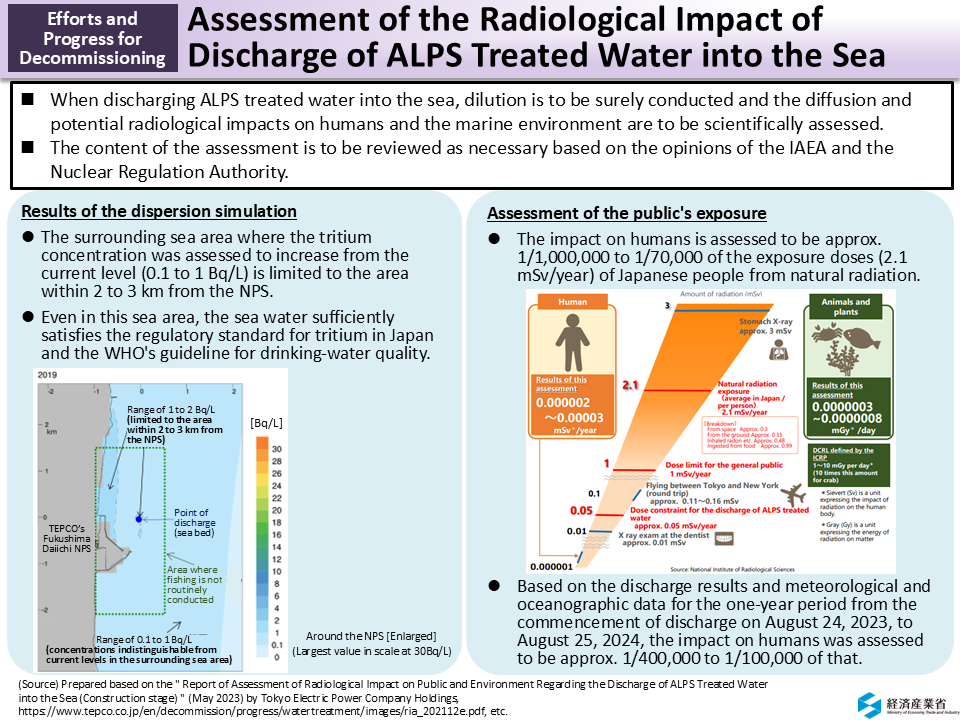Assessment of the Radiological Impact of Discharge of ALPS Treated Water into the Sea
Following the basic policy, which the Government of Japan announced in April 2021, Tokyo Electric Power Company Holdings conducted assessment on the radiological environmental impact when discharging ALPS treated water into the sea in accordance with internationally recognized methods (as found in the International Atomic Energy Agency (IAEA) Safety Standard documents and International Commission on Radiological Protection (ICRP) recommendations). The assessment was revised based on opinions received from Japan and abroad through a public comment procedure, observations in IAEA reviews and discussions with Nuclear Regulation Authority. The assessment result indicated that the impact on humans and the environment is minimal.
■ Results of the dispersion simulation in the sea (using the atmospheric and hydrographic data for 2019; annual average)
- The area where the concentration of tritium was assessed to be higher than that in seawater (0.1 to 1 Bq/L) in the current surrounding sea area is limited to the area within 2 to 3 km around the NPS.
- Tritium concentration assessed to be around 30 Bq/L was observed in some areas near the discharge outlet, but the concentration decreased rapidly in the vicinity of those areas. Even the tritium concentration of 30 Bq/L is sufficiently lower than 10,000 Bq/L, which is the standard level specified in the WHO Guidelines for Drinking Water Quality.
■ Results of radiological impact assessment on humans and the environment (assessment results as of February 2023)
- The impact on humans was assessed to be approx. 1/1,000,000 to 1/70,000 of the exposure doses (2.1 mSv/y) of Japanese people from natural radiation.
- The impact on plants and animals (flatfish, crabs, and brown algae) was assessed to be approx. 1/3,000,000 to 1/1,000,000 of the standard values at which impact could occur in living organisms as specified by ICRP. (Result of the assessment regarding crabs was approx. 1/30,000,000 to 1/10,000,000)
The operation stage began with the discharge into the sea in August 2023, and one year has passed in August 2024. Therefore, Tokyo Electric Power Company Holdings conducted radiological environmental impact assessment based on the discharge results and meteorological and oceanographic data for the one-year period from the commencement of discharge on August 24, 2023, to August 25, 2024. As was the case with the assessment conducted before the discharge of ALPS treated water, the assessment results indicated that the impact on humans and the environment is minimal.
■ Results of radiological impact assessment on humans and the environment (assessment results for the one-year period from the commencement of discharge on August 24, 2023, to August 25, 2024)
- The impact on humans was assessed to be approx. 1/400,000 to 1/100,000 of the exposure doses (2.1 mSv/y) of Japanese people from natural radiation.
- The impact on plants and animals (flatfish, crabs, and brown algae) was assessed to be approx. 1/1,000,000 of the standard values at which impact could occur in living organisms as specified by ICRP. (Result of the assessment regarding crabs was approx. 1/11,000,000)
(Source)
Prepared based on
- “Report of Assessment of Radiological Impact on Public and Environment Regarding the Discharge of ALPS Treated Water into the Sea (Construction stage)” (February 2023) by Tokyo Electric Power Company Holdings, Inc. https://www.tepco.co.jp/en/decommission/progress/watertreatment/images/ria_202112e.pdf
- “Radiological Environmental Impact Assessment Report Regarding the Discharge of ALPS Treated Water into the Sea (Operation stage)” (December 2024) by Tokyo Electric Power Company Holdings, Inc. https://www.tepco.co.jp/en/hd/newsroom/announcements/archives/2024/pdf/241209e0103.pdf
- Included in this reference material on March 31, 2022
- Updated on March 31, 2025

